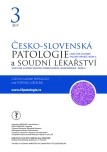Neuronal ceroid lipofuscinosis with cardiac involvement
Authors:
Silvia Farkašová Iannaccone 1; Peter Vasovčák 2; Dorota Sopková 1; Mária Pisarčíková 3; Marián Švajdler 4; Lucia Fröhlichová 5; Lucia Mistríková 6; Daniel Farkaš 7
Authors‘ workplace:
Bioptická laboratoř s. r. o., Plzeň
; Ústav súdneho lekárstva UPJŠ LF, Trieda SNP č. 1, Košice
1; PROGENET s. r. o., Strečnianska 13, Bratislava
2; Klinika pediatrickej anesteziológie a intenzívnej medicíny, Detská fakultná nemocnica Košice, Trieda SNP 1, Košice
3; Šiklův ústav patologie, Univerzita Karlova Praha, Lékařská fakulta Plzeň, Česká Republika
4; Oddelenie patológie, Univerzitná nemocnica Louisa Pasteura, Rastislavova 48, Košice
5; Kardiochirurgické oddelenie, Východoslovenský ústav srdcových chorôb, Ondavská č. 8, Košice
6; Úrad pre dohľad nad zdravotnou starostlivosťou, SLaPA pracovisko, Ipeľská 1, Košice
7
Published in:
Čes.-slov. Patol., 55, 2019, No. 3, p. 176-181
Category:
Original Articles
Overview
Neuronal ceroid lipofuscinoses (NCLs) are a group of inherited neurodegenerative disorders with clinical presentation predominantly in the childhood. The NCLs represent lysosomal storage disorders characterized by the accumulation of autofluorescent lipopigment storage material. The most common clinical features include development failure, psychomotor regression, seizures, and progressive loss of vision. We present a case of neuronal ceroid lipofuscinosis with cardiac involvement diagnosed post-mortem in a 9,5-year-old boy, whose clinical symptomatology comprised partial epilepsy, psychomotor decline and sinus bradycardia. In contrast to ventricular hypertrophy, being more frequently associated with NCLs, we discovered cardiac atrophy. Histologic examination of the heart revealed not only the lipofuscinosis affecting cardiac conducting cells and cardiomyocytes, but also basophilic degeneration of myocardium.
Keywords:
Neuronal ceroid lipofuscinosis – NCL7/MFSD8 – bradycardia – Basophilic degeneration of myocardium
Sources
1. Glykys J, Sims KB. The Neuronal Ceroid Lipofuscinosis Disorders. In: Swaiman FK, Ashwal S, eds. Swaiman´s Pediatric Neurology (6th ed). Edinburg: Elsevier; 2018 : 960-986.
2. Ostergaard JR, Rasmussen TB, Mølgaard H. Cardiac involvement in juvenile neuronal ceroid lipofuscinosis (Batten disease). Neurology 2011; 76(14): 1245-1251.
3. Michielsen P, Martin JJ, Vanagt E, Vrints C, Gillebert T, Snoeck J. Cardiac involvement in juvenile ceroid lipofuscinosis of the Spielmeyer-Vogt-Sjögren type: prospective noninvasive findings in two siblings. Eur Neurol 1984; 23(3): 166-172.
4. Fukumura S, Saito Y, Saito T, et al. Progressive conduction defects and cardiac death in late infantile neuronal ceroid lipofuscinosis. Dev Med Child Neurol 2012; 54(7): 663-666.
5. Hofman IL, Van der Wal AC, Dingemans KP, Beckrer AE. Cardiac pathology in neuronal ceroid lipofuscinoses – a clinicopathologic correlation in three patients. Eur J Pediatr Neurol 2001; 5(supll. A): 213-217.
6. Povyšil C, Šteiner I, et al. Speciální patologie (druhé, doplněné a přepracované vydání). Galén Karolinum 2007 : 306-307.
7. Haberland C. Clinical neuropathology. Text And Color Atlas. New York: Demos; 2007 : 174-175.
8. Armstrong D, Halliday W, Hawkins C, Takashima S. Pediatric Neuropathology: A Text Atlas. Tokyo: Springer; 2007 : 148-151.
9. Zeman W, Dyken P. Neuronal ceroid-lipofuscinosis (Batten’s disease): relationship to amaurotic family idiocy? Pediatrics 1969; 44(4): 570-583.
10. Haltia M, Goebel HH. The neuronal ceroid-lipofuscinoses: a historical introduction. Biochim Biophys Acta 2013; 1832(11): 1795-1800.
11. Mole SE, Cotman SL. Genetics of the neuronal ceroid lipofuscinoses (Batten disease). Biochim Biophys Acta 2015; 1852(10 Pt B): 2237-2241.
12. Gray F, Duyckaerts C, De Girolami U. Escourolle & Poirier Manual of Basic Neuropathology (5th edn.) Oxford: Oxford UIniversity Press; 2014 : 238-240.
13. Elleder M, Franc J, Kraus J, Nevšímalová S, Sixtová K, Zeman J. Neuronal ceroid lipofuscinosis in the Czech Republic: analysis of 57 cases. Report of the ‘Prague NCL group’. Eur J Paediatr Neurol 1997; 1(4): 109-114.
14. Kousi M, Siintola E, Dvorakova L, et al. Mutations in CLN7/MFSD8 are a common cause of variant late-infantile neuronal ceroid lipofuscinosis. Brain 2009; 132(3): 810-819.
15. Craiu D, Dragostin O, Dica A, et al. Rett-like onset in late-infantile neuronal ceroid lipofuscinosis (CLN7) caused by compound heterozygous mutation in the MFSD8 gene and review of the literature data on clinical onset signs. Eur J Paediatr Neurol 2015; 19(1): 78-86.
16. Coppoletta JM, Wolbach SB. Body Length and Organ Weights of Infants and Children: A Study of the Body Length and Normal Weights of the More Important Vital Organs of the Body between Birth and Twelve Years of Age. Am J Pathol 1933; 9(1): 55-70.
17. Rohan Z, Matěj R. Pitva mozku a míchy při diagnóze neurodegenerativního onemocnění – praktický postup pro optimalizaci vyšetření. Cesk Patol 2015; 51(4): 199-204.
18. Gray F, Duyckaerts C, De Girolami U. Escourolle & Poirier Manual of Basic Neuropathology (5th edn.) Oxford: Oxford UIniversity Press; 2014 : 10.
19. Imataka G, Yamanouchi H, Hirato J, et al. Autopsy report of a 7-year old patient with the mosaic trisomy 13. Cell Biochem Biophys 2013; 67(2): 813-817.
20. Graham DI, Lantos PL. Greenfield´s Neuropathology, Volume 1 (6th edn). Oxford University Press, Arnold: London; 1997 : 474.
21. Reske-Nielsen E, Baandrup U, Bjerregaard P, Bruun I. Cardiac involvement in juvenile amaurotic idiocy – A specific heart muscular disorder. Acta Path Microbiol Scand 1981; 89 : 357-365.
22. Buja LM, Butany J. Cardiovascular Pathology, Elsevier, Fourth Edition 4th Edition. 2016 : 59-60.
23. Buja LM, Butany J. Cardiovascular Pathology, Elsevier, Fourth Edition 4th Edition. 2016 : 111-112.
24. Rosai J, Lascano EF. Basophilic (mucoid) degeneration of myocardium: a disorder of glycogen metabolism. Am J Pathol 1970; 61(1): 99–116.
25. Miao N, Levin SW, Baker EH, et al. Children with infantile neuronal ceroid lipofuscinosis have an increased risk of hypothermia and bradycardia during anesthesia. Anesth Analg 2009; 109(2): 372-378.
Labels
Anatomical pathology Forensic medical examiner ToxicologyArticle was published in
Czecho-Slovak Pathology

2019 Issue 3
Most read in this issue
- Cytological examination of cerebrospinal fluid
- Neuronal ceroid lipofuscinosis with cardiac involvement
- Pituitary adenomas – practical approach to the diagnosis and the changes in the 2017 WHO classification
- Atypical fibroxanthoma, rare and often unrecognized cutaneous soft tissue tumor – a case report and review of the literature
